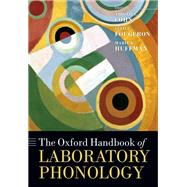
Note: Supplemental materials are not guaranteed with Rental or Used book purchases.
Purchase Benefits
What is included with this book?
| Acknowledgments | p. xii |
| The Contributors | p. xiii |
| Abbreviations | p. xxi |
| Introduction | |
| Introduction | p. 3 |
| Introduction, Papers in Laboratory Phonology I: Between the Grammar and Physics of Speech (reprint) | p. 10 |
| Conceptual foundations of phonology as a laboratory science (reprint) | p. 17 |
| Nature and Types of Variation: Their Interpretation Within a Laboratory Phonology Perspective | |
| Speaker-related variationùsociophonetic factors | p. 43 |
| Integrating variation in phonological analysis | p. 61 |
| Variation: Where laboratory and theoretical phonology meet | p. 62 |
| Modeling phonological variation | p. 76 |
| Message-related variation | p. 92 |
| Segmental within-speaker variation | p. 93 |
| Tonal variation | p. 103 |
| System-related variation | p. 115 |
| Multidimensional Representations of Knowledge of Sound Structure | |
| Lexical representations | p. 133 |
| Probing underlying representations | p. 134 |
| Asymmetric phonological representations of words in the mental lexicon | p. 146 |
| The lexicon: Not just elusive, but illusory? | p. 162 |
| The dynamic lexicon | p. 173 |
| Phonological elements | p. 184 |
| The nature of distinctive features and the issue of natural classes | p. 185 |
| Contrastive tone and its implementation | p. 196 |
| Modeling phonological category learning | p. 207 |
| Organization of phonological elements | p. 219 |
| Articulatory representation and organization | p. 220 |
| The role of the syllable in the organization and realization of sound systems | p. 232 |
| The temporal implementation of prosodic structure | p. 242 |
| Prosodic representations | p. 254 |
| Prosodic structure, constituents, and their implementation | p. 255 |
| Segment-to-tone association | p. 265 |
| NTonal alignment | p. 275 |
| Phonological representations in language acquisition: Climbing the ladder of abstraction | p. 288 |
| Changes in representations | p. 310 |
| The nature of historical change | p. 311 |
| The relationship between synchronic variation and diachronic change | p. 321 |
| Modeling exemplar-based phonologization | p. 332 |
| Integrating Different Perspectives: Insights From Production Perception, and Acquisition | |
| Insights from perception and comprehension | p. 347 |
| How perceptual and cognitive, constraints affect learning of speech categories | p. 348 |
| Representations of speech sound patterns in the speaker's brain: Insights from perception studies | p. 359 |
| Emergent information-level coupling between perception and production | p. 369 |
| Insights from acquisition and learning | p. 396 |
| How phonological representations develop during first-language acquisition | p. 397 |
| Speech processing in bilingual and multilingual listeners | p. 406 |
| Second-language speech learning | p. 417 |
| Methodologies and Resources | |
| Corpora, databases, and Internet resources | p. 429 |
| Corpus phonology with speech resources | p. 431 |
| Using the Internet for collecting phonological data | p. 441 |
| Speech manipulation, synthesis, and automatic recognition in laboratory phonology | p. 450 |
| Phonotactic patterns in lexical corpora | p. 458 |
| Articulatory analysis and acoustic modeling | p. 471 |
| Articulatory to acoustic modeling | p. 472 |
| Ultrasound as a tool for speech research | p. 484 |
| Methodologies used to investigate laryngeal function and aerodynamic properties of speech | p. 496 |
| On the acoustics and aerodynamics of fricatives | p. 511 |
| Prosodic analysis | p. 527 |
| Experimental methods and paradigms for prosodic analysis | p. 528 |
| Data collection for prosodic analysis of continuous speech and dialectal variation | p. 538 |
| Encoding, decoding, and acquisition | p. 548 |
| Studying the acquisition of a receptive phonetic/phonological system | p. 550 |
| Experimental methods and designs to investigate phonological encoding of spoken language | p. 562 |
| Measuring phonetic perception in adults | p. 572 |
| Eye movements as a dependent measure in research on spoken language | p. 580 |
| Neurophysiological techniques in laboratory phonology | p. 593 |
| Experimental design and data collection | p. 606 |
| Socially stratified sampling in laboratory-based phonological experimentation | p. 607 |
| Methods for studying spontaneous speech | p. 621 |
| Methods and experimental design for studying sociophonetic variation | p. 634 |
| Statistical analyses | p. 643 |
| Statistical methods in laboratory phonology | p. 644 |
| Mixed-effects models | p. 668 |
| Clustering and classification methods | p. 678 |
| References | p. 693 |
| Index | p. 849 |
| Table of Contents provided by Ingram. All Rights Reserved. |
The New copy of this book will include any supplemental materials advertised. Please check the title of the book to determine if it should include any access cards, study guides, lab manuals, CDs, etc.
The Used, Rental and eBook copies of this book are not guaranteed to include any supplemental materials. Typically, only the book itself is included. This is true even if the title states it includes any access cards, study guides, lab manuals, CDs, etc.